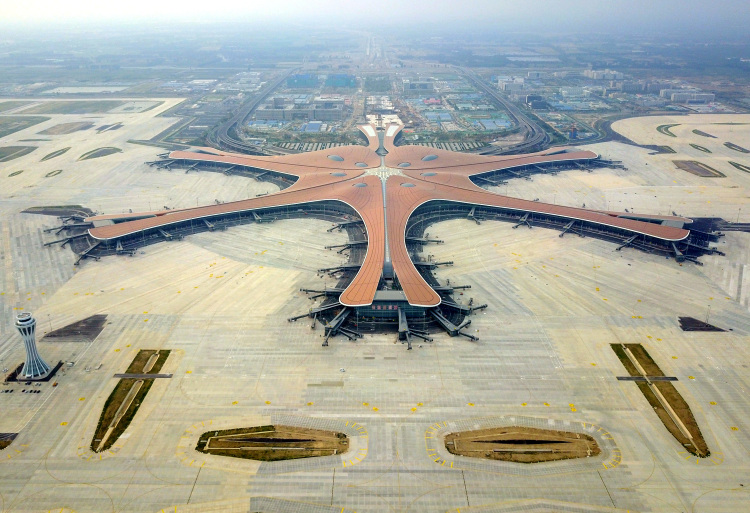This aerial photo taken on June 25, 2019 shows the terminal building of the Beijing Daxing International Airport in Beijing, capital of China. (Xinhua/Zhang Chenlin)
BEIJING, Feb.21 (Xinhua) -- A report released by Peking University's Beijing Development Institute shows that the average annual growth rate of the Beijing-Tianjin-Hebei collaborative innovation index hit 12.9 percent, showcasing the region's great progress made in coordinated development and innovation from 2013 to 2022.
"Jing-Jin-Ji" is the collective term for the neighboring regions of Beijing, Tianjin Municipality and Hebei Province. This important region in northern China boasts an area of 216,000 square kilometers and a population exceeding a hundred million.
However, unbalanced economic development has long been a bottleneck, so to optimize the urban layout and spatial structure, China started to boost the coordinated development of the region.
In recent years, the local governments have collaborated across industry, transportation and the environment to build a modern and new "capital economic circle" and city cluster. Data showed that in 2022, the economic aggregate of the region exceeded 10 trillion yuan (about 1.4 trillion U.S. dollars).
The newly released report, Beijing Tianjin Hebei Collaborative Innovation Index (2023), analyzes and measures the region's coordination and innovation progress based on open data through five indicators; innovation capacity, scientific research cooperation, technological linkage, innovation performance, and innovation environment.
The report demonstrates active cross-regional industrial activity and deepening industrial synergy. In 2022, cross-city or cross-province enterprises in the region set up 8,200 branches, increasing 8.7 percent year-on-year.
Technological exchanges in the region are also increasing. From 2013 to 2022, the total amount of technology transactions has shown an overall growth trend. The number of cooperative patents has grown by 6.6 percent annually. Among them, the high-tech industry in Beijing, Tianjin, and Hebei contributed 5.0 percent of GDP in 2022 from new product sales revenue, a 0.7 percentage points increase from 2019.
With steady investment and frequent cooperation on scientific research and development, the overall scientific research capacity of the region has also been enhanced. According to the report, the average annual growth rate over the ten years for academic papers co-published by researchers from the three places is 19.9%. The GDP devoted to research and development in the region increased from 3.22 percent in 2013 to 4.25 percent in 2022.
Li Guoping, director of the Beijing Development Institute of Peking University and the report publisher, said that the innovative output of the region significantly increased in recent years, especially high-level academic papers, patents, and technological achievements.
"According to our study, the innovation capacity index in the region has grown at an average annual rate of 15.1 percent over the past decade, demonstrating that the region's innovation capacity has reached new heights during these years," he noted.
Besides, remarkable progress has also been made in improving transportation, network and industrial park infrastructure. In particular, the integration of transportation lays a solid foundation for the coordination of innovation in the region.
The Beijing-Tianjin-Hebei region's railway network covered all prefecture-level cities by the end of November 2023, totaling 11,295 kilometers, 2,576 of which were high-speed rails.
Although marked achievements have been made in the coordinated development of the Beijing-Tianjin-Hebei region in the past 10 years, experts said to meet the ultimate goal, there is still a long way. The gaps mainly manifest in the lack of support and spatial interconnection of significant nodes, insufficient connectivity between industrial and innovation chains, and the unformed pattern of innovation-driven economic growth.
"The innovation coordination of the region requires the three places to improve their own innovation capacity continuously, and also to enhance cross-regional innovative cooperation," said Li.
In his opinion, to further advance the region's coordinated development and build it into a pilot demonstration area of Chinese modernization, the region still needs to promote the deep integration of the industrial chains and innovation chains, establish several advanced manufacturing clusters, and accelerate the construction of a world-class city cluster with Beijing as its core.
Source:
Xinhua News Agency
Written by:
Wei Mengjia
Edited by:
Tao Yiping, Yin Xingyu, Yu Xiaoyi
